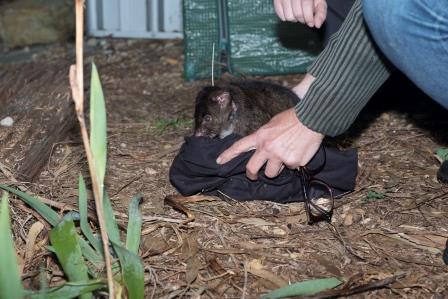Bronte Van Helden from UWA was awarded the WABSI PhD top up scholarship in 2018 and has been looking at how different types of urban areas differ in their ability to support animal biodiversity.
Bronte’s research to date highlights that residential gardens can play a significant role in biodiversity conservation and should not be overlooked when we consider management options in urban areas.
As urbanisation increases, the proportion of native species exposed to urban environments also increases, prompting the need to conserve fauna in urban landscapes. Whilst we know that remnant bushland in urban areas is critical for maintaining biodiversity, gaps in knowledge still exist about the importance of residential gardens for animal wildlife.
Bronte aims to address this knowledge gap through her PhD by investigating the conservation value of residential gardens for mammal conservation.

There are four key aims:
- How does the abundance and presence of mammals in residential gardens compare to urban bushland remnants?
- What garden features promote the presence and abundance of mammals in residential areas?
- Are mammals capable of exclusively living within gardens without any dependence on bushland?
- Do areas of urbanised environments acts as barriers to gene flow?
Bronte has just begun the third year of her PhD and has collected the majority of data required to answer these questions.
To address the first aim, a survey was conducted in 2018-2019 to investigate the presence and abundance of mammals in 52 gardens and at 20 bushland sites in Albany . Fieldwork across six weeks in all four seasons involved Bronte spotlighting for possums, detecting bats, whilst also cage and camera trapping for other ground-dwelling mammals such as bandicoots and native rats.
In 2017 and 2018 an online questionnaire was released to residents of Albany and Bunbury in collaboration with Rochelle Steven from the Threatened Species Recovery Hub. It asked residents about the type of gardens they had and what mammals were present. It helped establish how widespread mammals were in the cities; this addressed the second aim.
In May and June 2019, Bronte captured 20 western ringtail possums in 16 gardens and fitted them with radio-collars. Over the next three months, these animals will be tracked four times a week to determine where they move to, what resources they use and their home range size. The data will address the third aim.
Over the last two years Bronte has been opportunistically collecting DNA from western ringtail possums to address aim four. To date, approximately 150 samples have been collected from the Albany area and Bronte plans to use microsatellite analysis to evaluate the genetic structuring of this species in residential areas.
Bronte’s research will highlight that residential gardens can play a significant role in biodiversity conservation and should not be overlooked when we consider management options in urban areas.
It will inform planning and management actions aimed at conserving urban wildlife, and increase community awareness of and participation in wildlife-friendly gardening.
A word from Bronte: Financial support from WABSI has been invaluable
“Financial support from WABSI through the PhD Top Up Scholarship has been invaluable. I have been able to broaden my PhD and use all mammals to address my research questions. Prior to obtaining the support, I had intended to focus on the western ringtail possum and southern brown bandicoot only as this was all that was financially feasible. With the support from WABSI I was able to include multiple other methodologies including microsatellite analysis, detectors of bat echolocations, pitfall traps and camera traps which allowed me to include native rats, bats, brushtail possums, honey possums, dunnarts and kangaroos in my research. This has broadened the applicability and increased the value of my research. This has also enabled me to form collaborations.“
Bronte collaborated with Rochelle Steven from the Threatened Species Recovery Hub and released an online questionnaire to assess how widespread mammals were within two cities of southwest Australia as well as the garden features that predicted their presence within these areas. They also used this collaboration to assess the validity of species identification by citizen scientists. Both of these papers are currently in preparation for publication.
The support from WABSI generated interest in urban ecology at UWA in Albany and attracted international students from Bristol University, as well as students from Perth. This has resulted in an additional honours student and several masters students undertaking research projects in the field of urban ecology. Such increased interest is valuable in furthering our knowledge of conservation in urban areas, as well as ecological knowledge on the south coast of WA.
“The support from WABSI has also assisted me in attracting further financial support.”
Bronte’s PhD project has additional support from the Australian Geographic Society, Torbay Catchment Group (through an Australian Government Community Action Grant) and Oyster Harbour Catchment Group (through an Australian Government Community Action Grant).